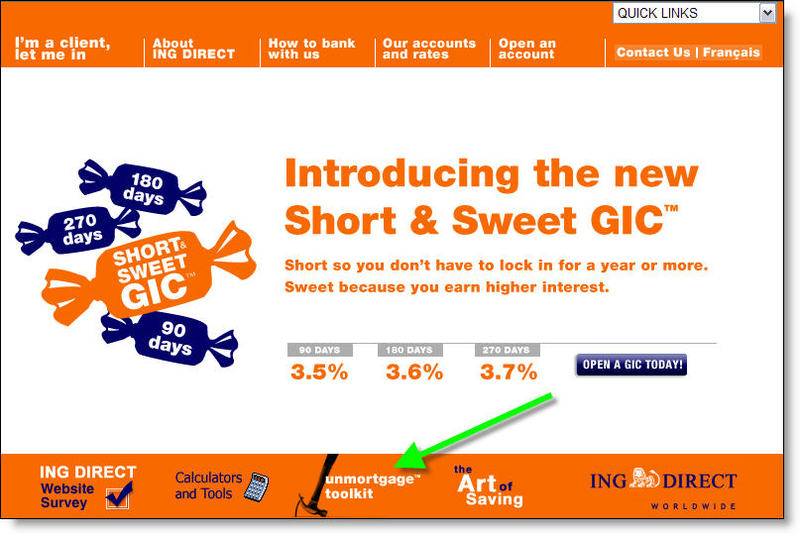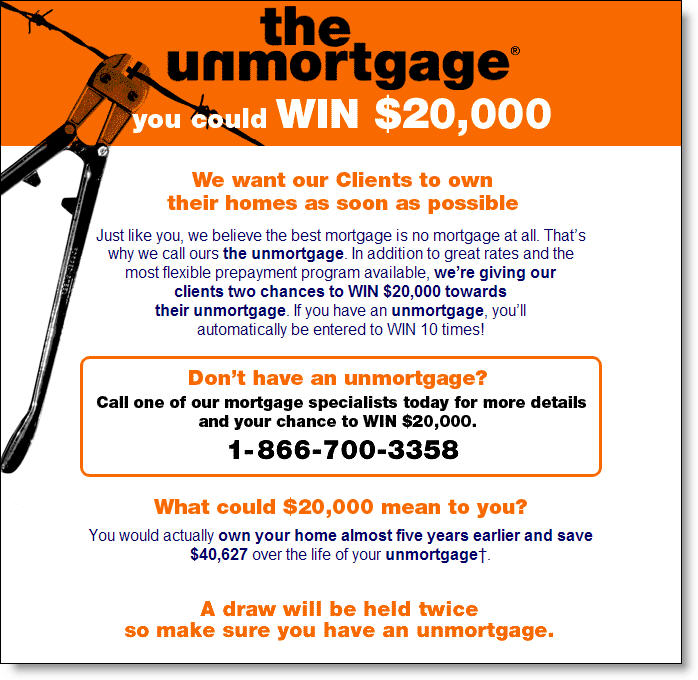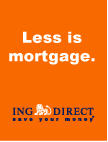 When everyone is swimming upstream, sometimes the best strategy is to head down. In the soft drink world, 7-Up's "uncola" campaign is legendary. The J Walter Thompson campaign launched in 1967 ranked 61st on Advertising Age's Top-100 All-Time Advertising Campaigns (compiled in 1999). In that spirit, ING Direct Canada's "unmortgage" campaign is bound to grab attention <ingdirect.ca>, even without the fizzy water.
When everyone is swimming upstream, sometimes the best strategy is to head down. In the soft drink world, 7-Up's "uncola" campaign is legendary. The J Walter Thompson campaign launched in 1967 ranked 61st on Advertising Age's Top-100 All-Time Advertising Campaigns (compiled in 1999). In that spirit, ING Direct Canada's "unmortgage" campaign is bound to grab attention <ingdirect.ca>, even without the fizzy water.
 How often have you seen "the best mortgage is no mortgage" at a lending site? The direct banking pioneer doesn't even use the word mortgage on its homepage, instead posting an "unmortgage toolkit" along the bottom navigation (click on inset for a closeup). To further reinforce the unmarketing strategy, an unmortgage sweepstakes promises $20,000 to two customers to assist in paying down their mortgage balance (see screenshot below).
How often have you seen "the best mortgage is no mortgage" at a lending site? The direct banking pioneer doesn't even use the word mortgage on its homepage, instead posting an "unmortgage toolkit" along the bottom navigation (click on inset for a closeup). To further reinforce the unmarketing strategy, an unmortgage sweepstakes promises $20,000 to two customers to assist in paying down their mortgage balance (see screenshot below).
 Analysis
Analysis
Unfortunately, the bank does not make good on its homepage promise. Clicking on the Unmortgage Tool Kit, simply drops users into a relatively standard mortgage page with information on new mortgages, refis, and home equity (see screenshot below). Where's the "help me unmortgage my home" button, or the "five steps to eliminating your mortgage" worksheet, or even a "talk to one of our unmortgage officers today" graphic.
 After a great tease, the company leaves users hanging. Hopefully, they'll remodel their mortgage page with ways for prospective customers to follow through on the unmortgage promise. Since ING trademarked it, you may not be able to use that clever name. But anyone can follow the powerful strategy of working to get your customers out of debt and back into the savings habit.
After a great tease, the company leaves users hanging. Hopefully, they'll remodel their mortgage page with ways for prospective customers to follow through on the unmortgage promise. Since ING trademarked it, you may not be able to use that clever name. But anyone can follow the powerful strategy of working to get your customers out of debt and back into the savings habit.
 In the United States, as baby boomers head into retirement often loaded with mortgage debt, "mortgage retirement" is likely to become a major focus in the personal-finance press for decades. Now is a good time to make your mark as the unmortgage expert in your area. While it may not land you on Ad Age's Top-100 list, it could keep your mortgage officers busy for years to come.
In the United States, as baby boomers head into retirement often loaded with mortgage debt, "mortgage retirement" is likely to become a major focus in the personal-finance press for decades. Now is a good time to make your mark as the unmortgage expert in your area. While it may not land you on Ad Age's Top-100 list, it could keep your mortgage officers busy for years to come.
—JB
Marketing Database –
If you're in need of inspiration for financial marketing ideas, check out the Interactive Financial Marketing Database from our sister publication, the Online Banking Report.





 ING Direct’s <
ING Direct’s <



